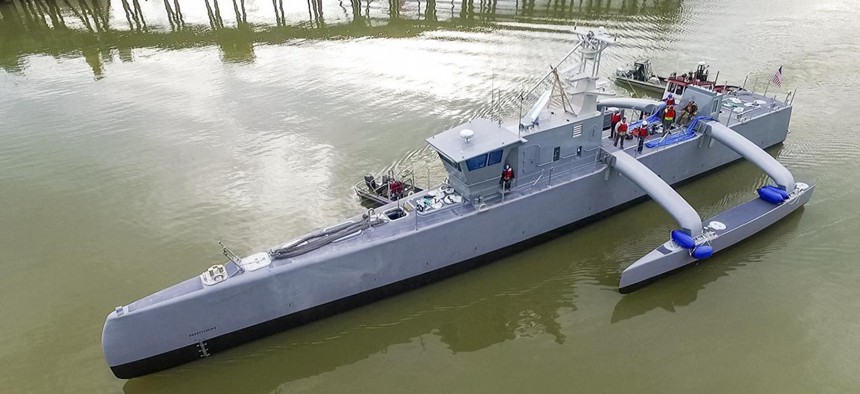How Robots Will Help the US Navy Avoid Future Collisions

The ACTUV, or Sea Hunter, vessel, a project co-developed by DARPA and the US Navy. DARPA
The Navy’s problems are very human in nature. The solution is less human.
Among the recommendations offered in the U.S. Navy’s new review of the year’s warship-related mishaps are some that will help prepare the fleet for interaction with the autonomous vessels that will soon be crowding the seas.
For example: accelerate plans to upgrade today’s electronic navigation systems. Teach crewmen to use automatic identification systems to broadcast their location to nearby ships. Improve methods for human systems integration.
Virtually all ships are required to have an automatic identification system, or AIS, that can receive information about nearby ships (in passive mode) and send data about themselves (in active mode). The U.S. Navy rarely uses active mode, which broadcasts a ship’s own location. That’s changing as a result of this year’s collisions involving the USS Fitzgerald, McCain, and Lake Champlain.
“In each of the three collisions, the U.S. Navy ships involved had an AIS receiver and transmitter, but maintained their AIS in receive mode only,” noted the 177-page review, dated Oct. 26 and released Nov. 1. “This removed one of the primary awareness and collision avoidance tools used on board most commercial vessels around the world. Further, they generally failed to use AISinformation to improve their situational awareness. Inadequate use of AIS was a contributing factor to the chain of errors that resulted in the incident.”
Of course, the military has some reservations about constantly broadcasting the course, future port, and other vital pieces of data to ships around it. Adm. Phil Davidson, who leads the Navy’s Fleet Forces Command, acknowledged in conversation with Defense One.
“There are places in the world where it’s pretty sporty” — meaning risky, to broadcast course and location data, Davidson said. “The Southern Red Sea, the Persian Gulf right now. The Strait of Hormuz, the Eastern Mediterranean. We have to be able to operate with that thing in passive or off. We have to be able to train our people to do such a thing as well.
“But, say for the East Coast of the United States, and where the Fitzgerald was operating [off Japan’s southeastern coast], they could have had it on.”
There’s a sound reason for a military to be conservative in the information it gives away, but that impulse is running up against a new reality. The seas are becoming more crowded, and not just with crewed ships. Future vessels will be ever more reliant on tools like AIS, and many of them will rely on them to replace human operators.
Japanese, Chinese, and Norwegian shipbuilders have announced plans to build self-driving robotic vessels. Google, working with Rolls Royce, is applying its Google Cloud Machine Learning Engine to develop autonomous ship driving techniques that any number of companies might adopt. In many ways, a robot helmsman has it easier than a self-driving car, so long as everybody is broadcasting enough data to be detectable to everyone else.
One key takeaway from the fatal collisions is that the Navy’s problems are very human in nature. Talking about the new report and its conclusions on Thursday, Adm. John Richardson, Chief of Naval Operations, said the Navy has too few people with too little training driving too few ships. There was, he said, too much pressure on the crewmen of ships in the Pacific to be everywhere at once, and that led to sailors steering ships and operating sensors and navigational equipment without proper training.
“These were fundamental mistakes of ship driving,” he said, mistakes compounded by issues related to operational pressures.
So why not replace, or at least augment, them with robotic ship drivers? The Navy has been developing various unmanned vessels of its own, notably the 132-foot Sea Hunter. When asked if there were specific technologies related to autonomous navigation or steering, or simply applications in artificial intelligence related to improving naval safety, Richardson remarked “We’ve done a lot of examination of that, Navy-wide, outside of the comprehensive review. It’s making progress. We’re monitoring that closely.”



